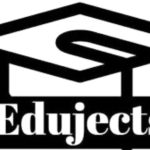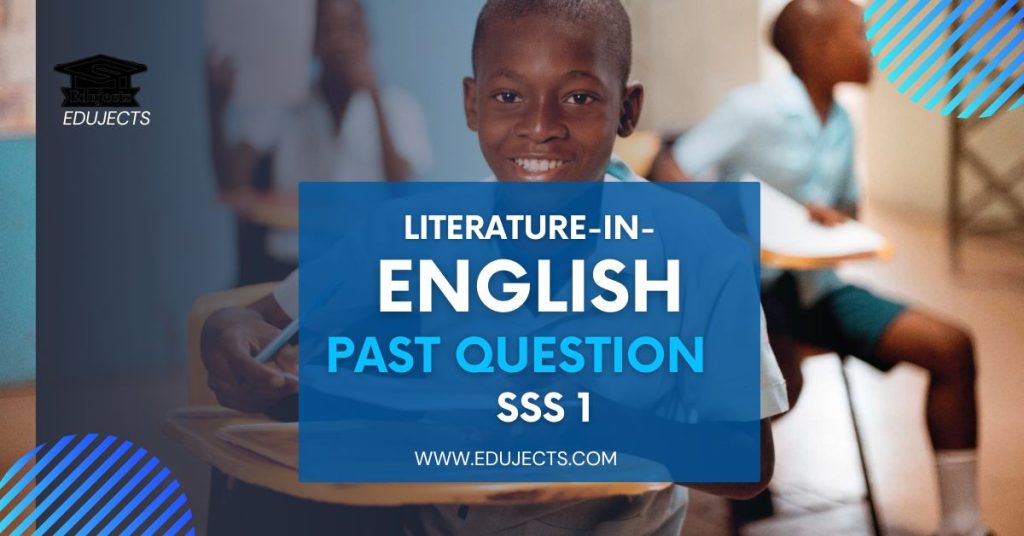SSI Literature Exam Question and Answers- 3rd Term for secondary school students and teachers.
CLASS: SS 1 SUBJECT: LITERATURE-IN-ENGLISH
- Answer ALL questions Part 1 and five in Part 2
- Answer each question in Section A by choosing one letter and shade it like this: [A] [B] [C] [D] [D]
- Do not shade two options in a question
- Erase completely any answer you wish to change.
- Do all rough work on this question
Read Also: JSS3 English Studies Examination- 3rd Term
SSI Literature Exam Question and Answers- 3rd Term
Section 1: Multiple Choice Questions.
- “Life is an empty dream” is an example of…….
- synecdoche
- litotes
- allusion
- elegy
- The pattern of end rhymes in a poem is called……
- internal rhyme
- rhyme scheme
- rhythm
- scansion
- The most exciting and tense part of a story is the……
- epilogue
- climax
- prologue
- exposition
- Lines of unrhymed poetry are known as…….
- blank verse
- assonance
- consonance
- free verse
- A folktale is a…….
- novel
- work of fiction
- biography
- novellette
- A poem written in an elaborate style style to adress pr celebrate an pbject pr event is called….
- a ballad
- an epic
- a dirge
- an ode
Read the following extract and answer questions 7-8
I have to thank God I’m a woman,
For in these ordered days a woman only
Is free to be very hungry, very lonely.
- The dominant device in the above lines is…..
- burlesque
- paradox
- conflict
- irony
- The tone of the poem is that of……..
- sorrow
- sarcasm
- happiness
- anger
- A long narrative poem which deals with heroic deeds is…….
- lyric
- epic
- ode
- euphony
- A literary piece used to mock or ridicule a society or practice is called…..
- an allegory
- a fable
- a farce
- a satire
- In a story, the adversary of the protagonist is the ……
- hero
- heroine
- antagonist
- foil
- When characters talk to each other, it is referred to as…….
- soliloquy
- monologue
- dialogue
- recitation
- A character whose flaws combined with external forces lead to his suffering is a……
- heroine
- tragic-hero
- hero
- protagonist
- The art of creating fictional personages constitutes……
- point of view
- characterisation
- narrative technique
- symbolism
- A piece of writing which teaches morals is…..
- serious
- didactic
- Playful
- analytical
- Shakespeare’s poetry consists mainly of …..
- quatrain
- heroic verse
- blank verse
- couplet
- A literary work written in form of a letter is……
- creative
- romantic
- tautology
- epistolary
- Foreshadowing is a device used to…….
- prepare the reader for the direction a plot will take
- introduce the plot.
- shed light on events through background information.
- recall the past
- Verbal irony occurs when a speaker on stage……
- says the opposite of what the speaker means
- is misunderstood
- tries to deceive the audience.
- is alone.
- humorous scene in a play intended to ease tension is……
- climax
- tragi-comedy
- comedy
- comic relief
- The term used to depict the freedom of a poet with language is…..
- poetic diction
- bathos
- graphology
- poetic licence
- A story which explains a natural phenomenon is …..
- legend
- parable
- myth
- fiction
- A short poem that expressesan idea in a clever way is…….
- an epigram
- a limerick
- an ode
- a lyric
- A character whose actions or qualities serve to heighten those of the hero through contrast is…….
- an adversary
- a protagonist
- an antagonist
- a foil
- ………….in drama, operates against a character whonis unaware of a situation which the audience know about.
- Verbal irony
- Dramatic irony
- Satire
- Parody
- An understatement is otherwise called…….
- litotes
- Hyperbole
- pun
- contrast
- The loneliest people live in the most crowded places illustrates……
- anecdote
- allegory
- paradox
- parody
- A character in the story who narrates what happens to him or her is……..
- a second person narrator
- a first person narrator
- an omniscient narrator
- a third person narrator
Read the following extract and answer questions 31-32.
Said the Lion: “On music I dote
But something is wrong with my throat
When I practice a scale
The listeners quail
And flee at the first note”.
- What type of poem is this?
- Epic
- Limerick
- Ode
- Sonnet
- The rhyme scheme of the poem is……..
- aabba
- ababa
- ababb
- abbaa
- “Many hands make light work” illustrates…….
- zeugma
- hyperbole
- metonymy
- synecdoche
- Soliloquy is a………. technique.
- descriptive
- dramatic
- narrative
- poetic
- The……… produces comic relief in drama.
- chorus
- protagonist
- antagonist
- clown
- He is my most beloved enemy illustrates…….
- synecdoche
- oxymoron
- metonymy
- litotes
- A poem which celebrates simple country life is……..
- pastoral
- a dirge
- an ode
- an epic
- Hamartia, in a literary work refers to a hero’s …….
- tragic flaw
- inordinate ambition
- strength of character
- good works
SECTION B
UNSEEN PROSE
Read the following passage and answer questions 37-
Each profession, intellectual or manual, deserves consideration, whether it requires painful physical effort or manual dexterity, wide knowledge or the patience of an ant. Ours like that of the doctor, does not allow for any mistake. You don’t joke with life, and life is both body and mind. To warp a soul is as much a sacrilege as murder. Teachers at kindergarten, as at university level-form a noble army accomplishing daily feats, never praised, never decorated. An army forever on the move, forever vigilant: an army without drums, without gleaming uniforms. This army thwarting traps and snares, everywhere plants the flag of knowledge and morality.
37.The writer’s mood is that of ……….
- excitement
- optimism
- indifference
- frustration
- The writer of the passage is……..
- doctor
- soldier
- teacher
D.student
- The dominant image in the passage is that of ……..
- soldiery
- medicine
- religion
D education
- The underlined illustrates …….
- antithesis
- allusion
- parallelism
- parody
41″ The flag of knowledge and morality” illustrates…..
- euphemism
B.litotes
- metaphor
- metonymy
SECTION C
“A Midsummer Night’s Dream”: William Shakespeare
Read the following excerpt and answer questions 42-
“…… I woo thee with my sword
And won thy love doing thee injuries.
But I will wed thee in another key,
With pomp, with triumph, and with reveling.
- Who is the speaker?
A.Theseus
- Lysander
- Oberon
- Demetrius
- Who is the addressed?
- Nedar’s daughter
- Helena
- Hermia
- Hippolyta
- ” my sword” in the above symbolises………
- war
- hatred
- protection
- duel
- What figure of speech is contained in the phrase “my sword” as used in the quote above?
- Metaphor
- Metonymy
- Personification
- Onomatopoeia
- “….won thy love doing thee injuries” is an example of …….
- irony
- oxymoron
- fallacy
- paradox
- Who entered after this discussion?
- Theseus
- Lysander
- Egeus
- Lysander
Read the following excerpt and answer questions 48-50
“How happy some o’er other some can be!
Through Athens I am thought as fair as she.
But what of that?…….thinks not so……
- Who made the above statement?
- Hermia
- Helena
- Oberon
- Lysander
- Who is the bone of contention here?
- Demetrius
- Lysander
- Hermia
- Helena
- Complete the above excerpt/statement of a character with the other part of it.
PART 2
1A. What is literature?
1B what are the functions of literature?
1C. Differentiate between sarcasm and irony.
2A. What is narrative point of view?
2B. Discuss clearly, the four narrative points of view taught in the class.
3A. Discuss with clear examples, five types of novels.
3B. Write briefly on setting.
- Discuss poetry as a genre of literature.
- Write short note on the following types of character with clear description of their characteristics.
- Foil
- Dynamic
III. Static
- Symbolic
- Tragic hero
6A. Explain with clear examples five sub-genres of comedy.
6B. Differentiate between metonymy and synecdoche.
- Write clear note on the following terms, with ample examples where applicable.
- Prologue
- Foreshadowing
III. Pathos
- Catharsis
- Sonnet

